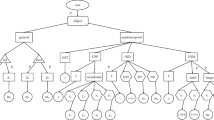Abstract
With spatiotemporal applications increasing, a large amount of spatiotemporal data emerges. Because temporal and spatial attributes are often vague, research on fuzzy spatiotemporal data, especially querying fuzzy spatiotemporal data, has attracted a lot of attention. However, although fuzzy logic is incorporated in querying fuzzy spatiotemporal data and querying fuzzy data in XML, relatively little work has been carried out in querying fuzzy spatiotemporal data in XML. In this paper, we propose an algorithm, called FSPTwigFast, to match fuzzy spatiotemporal XML twig pattern. We represent fuzzy spatiotemporal data by adding temporal and spatial attributes associating with fuzziness in crisp data. We extend Dewey code to mark fuzzy spatiotemporal data for special process and determine structure relationship of fuzzy spatiotemporal nodes in XML documents. Our technique uses streams to store leaf nodes in XML document corresponding to leaf query nodes, which are filtered to delete unmatched nodes. After filtering, output lists are built for every matched leaf node. Finally, the experimental results demonstrate the performance advantages of our approach.













Similar content being viewed by others
References
Bai LY, Yan L, Ma ZM (2013) Determining topological relationship of fuzzy spatiotemporal data integrated with XML twig pattern. Appl Intell 39(1):75–100
Bai LY, Yan L, Ma ZM (2014) Querying fuzzy spatiotemporal data using XQuery. Integrated Computer-Aided Engineering 21(2):147–162
Bennett B, Cohn AG, Wolter F, et al. (2002) Multi-dimensional modal logic as a framework for spatio-temporal reasoning. Appl Intell 17(3):239–251
Bruno N, Koudas N, Srivastava D (2002) Holistic Twig joins: optimal XML pattern matching. In: Proceedings of the 28th ACM SIGMOD international conference on management of data, pp 310–321
Buckles BP, Petry FE (1982) A fuzzy representation of data for relational databases. Fuzzy Sets Syst 7 (3):213–226
Chang YS, Park HD (2006) XML Web Service-based development model for Internet GIS applications. Int J Geogr Inf Sci 20(4):371–399
Chen Y, Revesz P (2003) Querying spatiotemporal XML using DataFox. In: Proceedings of the 2nd ACM international conference on web intelligence, pp 301–309
Claramunt C, Thériault M (1995) Managing time in GIS an event-oriented approach. In: Proceedings of the international workshop on temporal databases: recent advances in temporal databases, pp 23–42
Córcoles JE, González P (2004) Using RDF to query spatial XML. In: Proceedings of the internal conference on web engineering, pp 316–329
Emrich T, Kriegel HP, Mamoulis N, et al. (2012) Indexing uncertain spatio-temporal data. In: Proceedings of the 21st CIKM, pp 395–404
Ferreira N, Poco J, Vo HT, et al. (2013) Visual exploration of big spatio-temporal urban data: A study of New York City taxi trips. IEEE Trans Vis Comput Graph 19(12):2149–2158
Gaurav A, Alhajj R (2006) Incorporating fuzziness in XML and mapping fuzzy relational data into fuzzy XML. In: Proceedings of the 2006 ACM symposium on applied computing, pp 456–460
Hu L, Ku WS, Bakiras S, et al. (2013) Spatial query integrity with voronoi neighbors. IEEE Trans Knowl Data Eng 25(4):863– 876
Hurricane forecast of Atlantic (2014) https://www.wunderground.com/?MR=1
Liu J, Ma ZM, Qv Q (2014) Dynamically querying possibilistic XML data. Inf Sci 261(4):70–88
Liu J, Ma ZM, Yan L (2011) Matching twigs in fuzzy XML. Inf Sci 181(1):184–200
Lu J, Ling TW, Chan CY, et al. (2005) From region encoding to extended dewey: on efficient processing of XML twig pattern matching. In: Proceedings of the 31st VLDB, pp 193–204
Lu J, Chen T, Ling TW (2004) Efficient processing of XML twig patterns with parent child edges: a look-ahead approach Proceedings of the 13th CIKM, pp 533–542
Nørvåg K (2002) Temporal query operators in XML databases. In: Proceedings of the 2002 ACM symposium on applied computing, pp 402–406
Obeid N (2005) A formalism for representing and reasoning with temporal information, event and change. Appl Intell 23(2):109–119
Open GIS Consortium Inc. (OGC) (2001) Geography Markup Language (GML). http://www.opengis.net/gml/01-029/GML2.html
Pfoser D, Tryfona N (1998) Requirements, definitions, and notations for spatiotemporal application environments. In: Proceedings of the 6th ACM international symposium on advances in geographic information systems, pp 124–130
Pelekis N, Theodoulidis B, Kopanakis I, et al (2004) Literature review of spatio-temporal database models. Knowl Eng Rev 19(3):235–274
Rizzolo F, Vaisman AA (2008) Temporal XML: modeling, indexing, and query processing. Very Large Data Bases 17(5):1179–1212
Senellart P, Abiteboul S (2007) On The complexity of managing probabilistic XML data. In: Proceedings of the 26th ACM SIGMOD-SIGACT-SIGART symposium on principles of database systems, pp 283–292
Sözer A, Yazici A, Oğuztüzün H (2015) Indexing fuzzy spatiotemporal data for efficient querying: a meteorological application. IEEE Trans Fuzzy Syst 23(5):1399–1413
Sözer A, Yazici A, Oğuztüzün H (2008) Modeling and querying fuzzy spatiotemporal databases. Inf Sci 178(19):3665–3682
Tatarinov I, Viglas S, Beyer KS, et al. (2002) Storing and querying ordered XML using a relational database system. In: Proceedings of the 2002 ACM SIGMOD international conference on management of data, pp 204–215
Zadeh LA (1978) Fuzzy sets as a basis for a theory of possibility. Fuzzy Sets Syst 1(1):3–28
Acknowledgements
The work was supported by the National Natural Science Foundation of China (61402087), the Natural Science Foundation of Hebei Province (F2015501049), the Scientific Research Fund of Hebei Education Department (QN2014339), and the Technology Support Project of NEU (XNK2015003).
Author information
Authors and Affiliations
Corresponding author
Rights and permissions
About this article
Cite this article
Bai, L., Li, Y. & Liu, J. FSPTwigFast: Holistic twig query on fuzzy spatiotemporal XML data. Appl Intell 47, 1224–1239 (2017). https://doi.org/10.1007/s10489-017-0949-5
Published:
Issue Date:
DOI: https://doi.org/10.1007/s10489-017-0949-5




